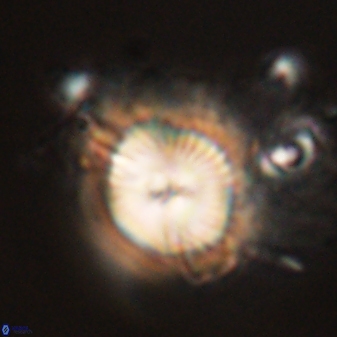Caycedoa grandis
Set number: 598
-
1
-
2
-
3
-
4
-
5
-
6
-
7
-
8
-
9
-
10
-
11
-
12
-
13
-
14
-
15
-
16
-
17
-
18
-
19
-
20
10µm
in mobile mount
Caycedoae grandis Bowman & Varol, 2021
Large and circular species of Caycedoa having a single non-birefringent disc and a birefringent very high column with concave peripheries, a central canal and a distal depression.
From Latin grandis, large—referring to the enormous size of the column and massive size of the species in general.
Overall height: 9.64μm; Column height: 6.00μm, Column diameter (maximum): 7.42μm; Disc diameter: 15.08μm.
Very large (10.0–16.0μm) and circular species of Caycedoa consisting of one disc and a column. The disc is very wide and displays a subtle depression on the proximal side (best seen in the side view). The very high column is wide (e.g. width>height, or maybe almost equal) and flaring out distally (i.e. away from the disc) and possesses a central canal and a depression on the distal end. The disc is constructed of about 26–36 segments, but the column segments are indistinct.
The extinction lines are dextrogyre on the distal/column side but laevogyre on the proximal/disc side. When viewed using a gypsum plate, the horizontal axis occurs within the blue sector on the distal side, but the vertical axis exists within the blue sector on the proximal side. In plan-view, the column displays a serrated edge and appears reddish-yellow under polarised light. The disc is non-birefringent, and the column is birefringent in plan-view. The disc and column are birefringent in the side-view.
Caycedoa grandis possesses a massive column with a serrated edge, whereas these diagnostic features are absent in the Caycedoa megastypus. Caycedoa grandis and Caycedoa megastypus each have a distally flaring column with concave peripheries, which distinguish them from other Caycedoa species.
Bowman, A. R. & Varol, O. 2021. A Taxonomic Revision of Heliolithaceae - Applications in Resolving the Problematic Calcareous Nannofossil Biostratigraphy of the Paleocene. In: M. Montenary, M. (Ed.). Calcareous nannofossil biostratigraphy of the Stratigraphy and timescales. 6: 43-223.
